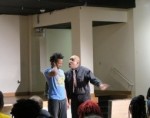
How is a Ballet Like a Plane Explosion?
by Jenna Horton
January 11, 1938. Captain Musick in command of the Pan American S-42 flying boat, otherwise known as the Samoan Clipper, and a crew of six. The first scheduled airmail flight to Auckland, New Zealand from Pago Pago, American Samoa. Exploded midair. Oil, debris, burnt clothing, and mail found by a United States Navy Avocet Minesweeper. Bodies never recovered.
November 20, 2016. Choreographer Matthew Neenan in command of the BalletX ensemble. Closing matinee show of Sunset, o639 Hours, remounted for the company’s Fall Series at the Wilma Theater in Philadelphia, PA. Complaints of the blustery Sunday weather populate the heated lobby. Two young girls, newer to the thrill of dressing up for the ballet, wear gold bows in their hair that match their glittery stockings.
A low hum undergirds the theater. The sound—mechanical and dry— resonates, eerie in its thinness, the threat of silence just below. The dancers drift in, populating the stage one-by-one in quiet, abstract undulations. The audience, shedding coats as they drift in, too, cling to the rhythm of daily life with rustling hellos and small talk.
Three rectangles hang suspended in warped positions, tussled by a non-existent wind. Designed by Maiko Matsushima, they evoke paper, airplane doors, Dali, and Calder. They hang beautifully, three-dimensional against the deep blue-to-lush-pink-and-now-grey hues of Drew Billiau’s lighting on the scrim behind.
This full-length episodic ballet follows the lives of Musick’s crew in the Pacific Basin. Neenan takes us to a sultry 1930s club for New Year’s Eve, to a refueling stop in Samoa, to basking on the beach during a week off in Hawaii—leading up to the accidental explosion. The structure mimics rifling through a box of postcards and memorabilia, a hodge-podge constellation revealing the intersection of political happenings, dance styles, and the significant insignificances of personal lives. “I’ve been climbing more trees,” writes George in Honolulu to Shirley in New Zealand.
I’m usually not one for narrative episodic story telling. Call it a personal bias. Chronology, especially for historical retelling, can be too damn easy. Too much “this happened” and “then this happened” and “then this happened” gets list-like and can be a stand-in for actually understanding relationship or dynamic between components. Changing flavors over and over can excite the palate, but relies on the excitement of ‘next’ as opposed to relishing the contrast of what exists. Sunset, o639 Hours narrowly avoids that peeve of mine with a host of strong elements in triangulation to keep it buoyant.
Neenan’s collaboration with composer Rosie Langabeer, for instance, creates dynamic, listening edges to the entire piece. Langabeer, Joshua Machiz, Andrew Mars, and Isaac Stanford move seamlessly from piano, voice, bass, drums, to steel guitar as they converse with the very capable ensemble of BalletX dancers. The music fluctuates between luxuriating in the nostalgia of a 1930s aesthetic to emptying out into a more spacious Cage-ian soundscape filled with exotic birds or large hulking machinery.
What looks like a bowling ball floating over a magnet is one of many instruments, all invented by Neil Feather, sitting on stage. Their mechanical vibrations provide an effective contrast to the sweating, singing, swinging flesh of the dancers’ expert bodies. The dancers line up to create different parts of the Samoan Clipper, arms interlocked and synchronized, extended like rigid wings, geometrically rotating, approaching the uncanny. These images vibrate with paradox and reveal the dancers’ ability to communicate machine through the forms of ballet and their simultaneous and definitive failure simply by virtue of being bound by their own muscle, flesh, and bone.
As they were discovering they would need to turn back to Samoa and drop fuel for an emergency landing, what sensations flooded the minds of Captain Musick, Navigator F. J. MacLean and Flight Mechanic J. A. Brooks? Did it feel anything like this?
The fluid ensemble fills whatever narrative need arises by becoming exotic birds now, drunken party guests later, pining lovers next— always with a pointed foot or flourish. Like sunsets, the dancers’ transitions from plane to bird, from forest floor to fuselage, expose and excite me the most. In transition, we experience, momentarily, what we leave behind and where we are going. I feel Sunset, o639 Hours most palpably when it leaves the comfort of its plateaus and commits to its fleeting eddies and dreamlike currents, the rubbing of cold electric sound against the small human marvel written in a letter, “Can you believe it’s Thanksgiving already?” A canopy of birds chirping to an organic rhythm against the tapping of a “one, two, three, four and twist.”
Sunset, o639 hours, BalletX, Wilma Theater, November 16-20, https://balletx.org/repertory/sunset-o639-hours/
By Jenna Horton
November 26, 2016







